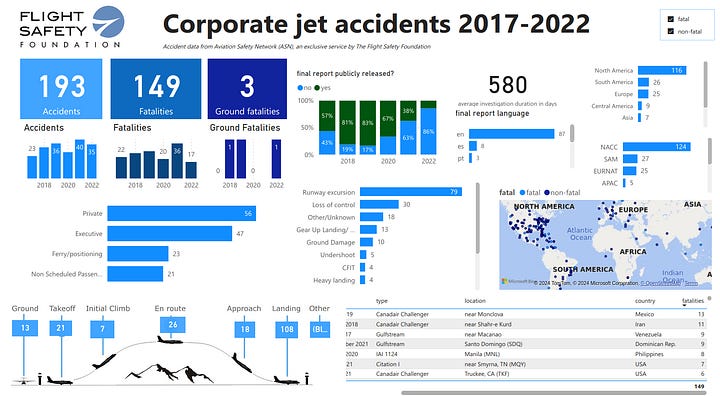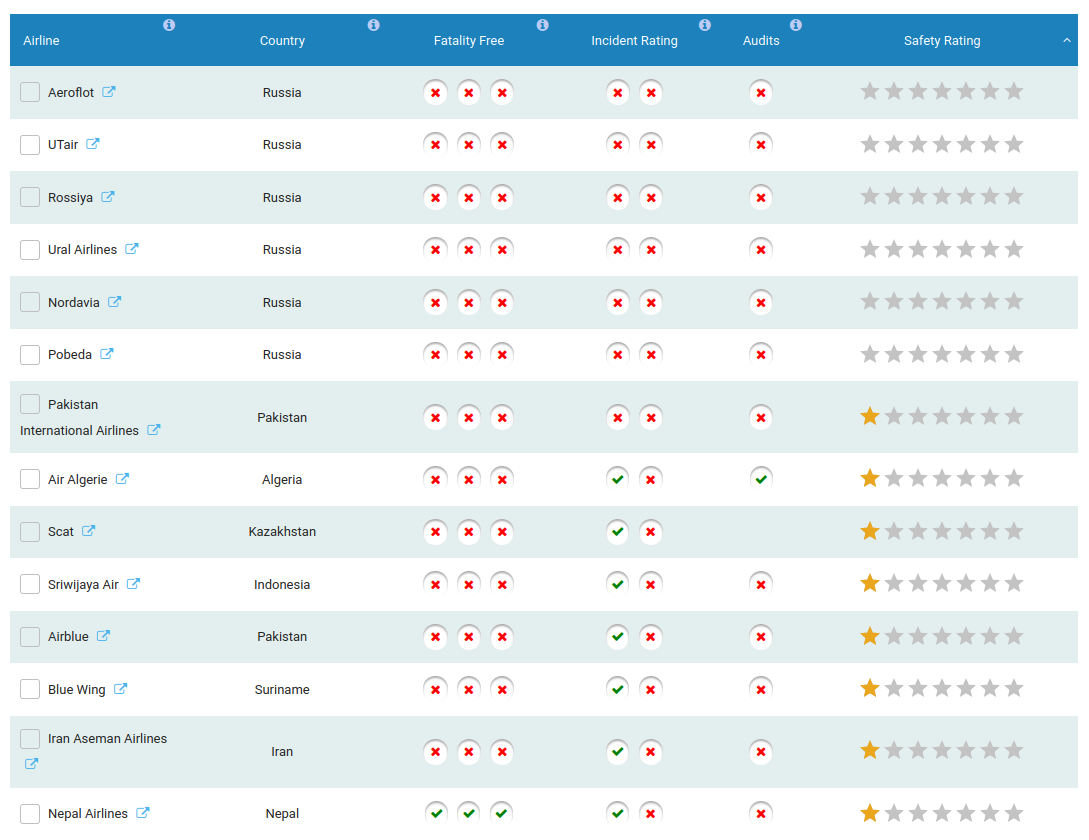Statistically, air travel is recognised as the safest mode of transportation. Data from the Flight Safety Foundation's Aviation Safety Network (ASN) highlights that between 2017 and 2022, there were 1,779 fatalities associated with air travel. This figure stands in stark contrast to road traffic statistics reported by the World Health Organization (WHO), which notes approximately 1.3 million people die annually in road traffic incidents, with an additional 20 to 50 million sustaining non-fatal injuries, some leading to long-term disabilities.


When these numbers are compared, the safety of air travel becomes evident, even without detailed information on the frequency of flights or the total distance covered.
While there has been a widespread belief that commercial passenger aeroplanes offer greater safety than corporate jets, due to a supposed lack of safety features and less rigorous pilot training requirements, conclusive statistical data to support this claim is lacking. Without substantial statistical data to corroborate this, passengers are advised to consider airlines' safety records and regulatory compliance when making their choices.
Nonetheless, the International Air Transport Association (IATA) released its safety performance data for the commercial airline industry, indicating considerable safety improvements across various metrics when compared to the figures from 2005 to 2023
Despite the inherent safety of air travel, it surpasses most other forms of transportation in terms of safety. For those hesitant about flying, alternative safe transit options include trains, buses, and ferries/boats, all of which are considerably safer than travelling by car.
Knowledge is power
If you have read the previous article, you might wonder, “OK, I might survive a tsunami, but how can I possibly survive a plane crash?” The thought of surviving a plane crash might seem far-fetched. Yet, understanding the dynamics of aviation incidents can shift the odds in your favour, embodying the adage that knowledge indeed is power. Detailed statistics by the International Air Transport Association (IATA), spanning from 2005 to 2023, shows that a significant proportion of accidents transpire during critical flight phases such as landing, take-off, approach and initial climb.
Furthermore, examining the Accidents by End States reveals that most accidents are caused by runway excursion, landing gear issues, ground damage, hard landings, in-flight damage, loss of control in flight, tail-strikes, controlled flight into terrain. Off-runway touchdowns, runway damage, and off-airport landings or ditching. This data elucidates that many incidents occur in proximity to the ground, presenting an opportunity to escape, particularly within the crucial window of approximately 90 seconds post-incident.
It is important to remember that there are other incidents that can happen besides crashes. An emergency landing can be deadly. However, if you are ever in the unlikely position of experiencing an emergency in an aircraft, there are some tips you can use to increase your chance of survival.
Selecting Your Airline
In the article on Travel Safety Awareness, I highlighted the importance of pre-planning in selecting your destination, given that dangers can vary significantly from one country to another, and even from region to region or city to city. This principle is equally crucial when choosing an airline, as not all airlines adhere to the same rigorous standards. Some may operate older fleets, have lapses in maintenance protocols, or exhibit inadequacies in staff training, possibly overburdening pilots in the process.
For an informed evaluation of airline safety, AirlineRatings.com is recommended, acclaimed as “The world’s foremost one-stop airline safety and product rating review site”. Their comprehensive reviews offer invaluable insights. Nonetheless, diversifying your research across multiple platforms is advisable to ensure a well-rounded understanding.
Plus 3 / Minus 8
The “Plus 3 / Minus 8” rule underscores the crucial minutes during a flight: the first three minutes after take-off and the last eight minutes before landing. Flight crash investigators have found that most accidents occur during these periods. Enhancing your survival chances involves being prepared and mindful of the following:
Opt for Non-flammable Clothing: Wearing clothes made from natural fibres like cotton, wool, or leather can provide better protection against heat and flames compared to synthetic materials. Choose long sleeves and trousers over shorts, and opt for outfits that fit snugly to avoid snagging during an evacuation. Layering can offer additional protection; in the event of a fire, removing a layer can also eliminate a potential fuel source.
Wear Appropriate Footwear: Select comfortable, closed-toe shoes crafted from sturdy, non-synthetic materials. Such footwear protects against sharp debris and remains secure on your feet, unlike sandals or flip-flops, which are prone to slipping off.
Maintain Vigilance: Resist the urge to sleep immediately after boarding, and if you decide to nap, ensure you're awake before the plane begins its descent.
Minimise Distractions: Store away electronic devices and reading materials to stay alert to your surroundings and any instructions from the flight crew.
Fasten Your Seat Belt Securely: A properly fastened seat belt is your first line of defence against turbulence and other in-flight incidents.
Limit Alcohol Consumption: Even before boarding, avoiding alcohol can enhance your responsiveness and decision-making capacity in the event of an emergency.
The Five-Row Rule
Although the common belief is that if the plane crashes it goes down nose first, this is not always the case, sometimes the tail hits first. Maximum chance of survival, either in a crash or emergency landing situation, comes from being able to get off the plane in 90 seconds to avoid the fire and smoke. Choosing a seat, no more than 5 rows away from an exit, will give you the best chance. Try booking the exit row for maximum access. Although people often like a window seat, aisle seats are better in an emergency where you don’t have anyone else to get past before heading to the exit. If you book online, you can see your seat location and select the one you want, and when doing so you should remember the 5-row rule.
Read the Safety Card
Most people ignore the safety card and the flight attendant’s safety drill. Of course, you may have heard the speech a dozen times; you know how to fasten a seatbelt and what to do if that oxygen mask drops down. However, make it a rule to pay attention and read the safety card every time. Planes have different designs and the exits may not be where you’d normally expect them.
It is always good to refresh your mind about things like life jackets, the brace position and how your seat cushion can be used as a flotation device. It takes 2 minutes to read, yet only 1% of passengers bother to do so.
Evacuate within 90 seconds
We have all seen the news footage of the aftermath of plane crashes and, faced with this level of devastation, it is easy to assume that there is no chance of survival. However, most passengers who survive the impact are likely to fall victim to smoke inhalation from the resulting fire
The gold standard for aviation safety is that all passengers must be able to be evacuated within 90 seconds. This small window of opportunity is the time you have before you become likely to die of smoke inhalation.
Leave It Behind
Leave all personal items behind. The only important thing is to get yourself and your family to safety. Although this sounds obvious, we can sometimes react strangely in an emergency situation, so keep it in mind. Yes, this also means to leave your phone behind.
Move, move, move!
Ninety seconds can go by in the blink of an eye, but this is the total amount of time you have to get off that aircraft. It is not uncommon for people to freeze when in a life or death situation, but you must override this and act immediately. You cannot predict how you will react at the time. By thinking about these things before the event and having a plan of what you would do, you are more likely to be able to motivate yourself and your family to get off that plane immediately.
To summarise, use this helpful pre-take off checklist:
Pre-Take-off Checklist
Count the seats to the nearest exit.
Observe potential obstacles.
Keep your shoes on and seatbelt fastened.
Review the emergency card.
Check for life jackets or flotation devices
Stay awake, especially during take-off and landing.
By adhering to these guidelines, you empower yourself with the knowledge and actions needed to navigate the rare event of an aviation emergency safely. Flying remains one of the safest modes of transportation, and by taking personal responsibility for your safety, you contribute to maintaining this record.






